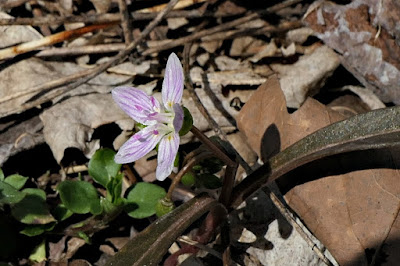On March 30th Joan and I returned to Boch Hollow State Nature Preserve, this time parking at the west entrance. This day's hiking complemented and a bit overlapped the previous hike, which started from the east entrance.
After a gentle climb we reached the west pond.It's not a good idea to go out on that deck.Passing along the north side of the pond, we heard and then spotted a singing towhee.Up to the top of the ridge we went, and then down the far side.This is the time of year when the plants that live on the forest floor feast on sunlight for growth and reproduction, before the tree canopy above them fills in. For instance, the rue anemoneand bloodroot blooms
were popping out from the leaf litter. When the bloodroot is fully unfurled, the different sizes of alternate petals gives it a square-ish appearance.Another pond, not far from the north entrance.Joan and I tromped on. Here, rue anemone and a spring beauty.We've become quite adept at spotting the prior-year red-eyed vireo nests.The land of Boch Hollow once hosted farming homesteads, and the old roads can appear much like the trails at times. The preserve is signed to prevent hikers going astray, both positively,and negatively.In the sunlight the blue-green lichen stood out, clinging to the sandstone faces. |
| Wearing a moss toupée. |
We came across another hiker, who warned us that there was a prescribed burn ahead and the trail was closed. Joan and I kept going, and on reaching intersection F, we could see smoke and workers in fluorescent jackets ahead. Time to turn around and pass through G and H to reach the next valley.In the valley we were amazed to see, just off the trail, the remains of an accipiter, which here in Ohio was likely either a sharp-shinned or or Cooper's hawk. We have no idea what befell it.
 |
| The head is missing. |
 |
| Please, if you can carry it in, you can carry it out! |































